Contrast that with today's cramped seats and overcrowded airports and it looks like our flying experiences are getting steadily worse.
But is this based on reality?
The aviation industry has been investing massively to prove nostalgic travelers wrong.
Yes, aircraft may still look similar to those of the so-called golden years.But every single aspect of the air travel experience is currently being overhauled — all driven by technology.
Right at the forefront are airplane cabins.
And key to their transformation is wireless connectivity.
With virtually every passenger toting a smartphone, tablet or laptop, inflight Wi-Fi is opening up new ways to engage with air travelers and redefine the flying experience.
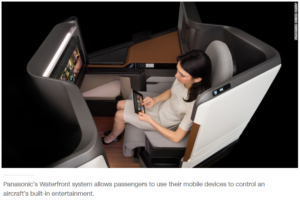 Mobile tech already plays an important role in enhancing travel, from electronic boarding passes to last-minute bids on biz class upgrades.
Mobile tech already plays an important role in enhancing travel, from electronic boarding passes to last-minute bids on biz class upgrades.Some airlines, such as KLM, have even started sending boarding passes and flight alerts through a dedicated airline Facebook Messenger chat bot.
But the one area where mobile can become truly transformative is inflight entertainment, with personal devices becoming gateways to a whole range of up-in-the-air services.
While built-in in-flight entertainment systems are unlikely to vanish, particularly on long-haul flights, they can work in tandem with the passenger's own devices.
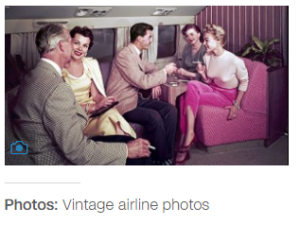 Earlier in 2016, Panasonic unveiled Waterfront, a system that allows the passengers to use their mobile handsets to control an aircraft's built-in entertainment.
Earlier in 2016, Panasonic unveiled Waterfront, a system that allows the passengers to use their mobile handsets to control an aircraft's built-in entertainment.Aerospace companies Thales and B/E are also using mobiles to personalize passenger experiences.
By syncing with handsets, their seats know a passenger's preferences and can even restart a movie at the exact place where they left it in the previous flight.
Some airlines are doing away with embedded entertainment systems altogether.
They're opting for passenger's handsets to deliver inflight entertainment — a move that crucially reduces aircraft weight and frees up cabin space.
No Internet connection is required, passengers just connect their devices to an in-plane network.
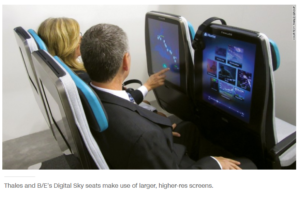 Netherlands-based AirFi is primarily equipping low-cost airlines that often fly short-haul single-aisle aircraft and don't have entertainment systems.
Netherlands-based AirFi is primarily equipping low-cost airlines that often fly short-haul single-aisle aircraft and don't have entertainment systems.
The company's portable wireless system beams pre-loaded content onto passenger devices.
The AirFi terminal behaves like a normal Internet router. It's lightweight and can easily be installed in a luggage compartment.
AirFi CEO Job Heimerikx says it's a cost effective and flexible way to provide quality inflight content to the short haul market.
"There are a customer service and a commercial angle to our system," he says.
"Passengers can access a broad range of movies and other sort of entertainment, but they can also use it to order food or shop duty free.
"It's like an evolution of the traditional inflight magazine, but just as it happens at online stores, you can make it really personal."
This concept thrives on having a captive audience.
But would it still work if users had a full inflight broadband Internet connection?
Passengers might be more interested in binge-watching their favorite TV series instead of booking airport transfers or ordering an extra cup of coffee.
Virtual reality
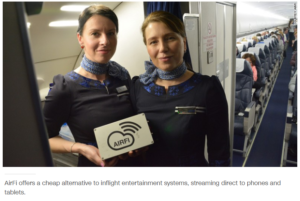 "If airlines can't stop the passenger from going to Amazon or zoning out on Netflix for three hours… and they can't offer something at least equally interesting in terms of intuitive retail and custom content, they are missing a number of tricks" says Maryann Simson of Runway Girl Network, a leading aviation news website focusing on passenger experience.
"If airlines can't stop the passenger from going to Amazon or zoning out on Netflix for three hours… and they can't offer something at least equally interesting in terms of intuitive retail and custom content, they are missing a number of tricks" says Maryann Simson of Runway Girl Network, a leading aviation news website focusing on passenger experience.
It's a theory that'll get put to the test soon.
Aeromexico recently announced it would use Gogo's 2Ku satellite-based Internet connection to offer Netflix-enabled flights.
"More than 80% of passengers are walking on the plane with their own device," Gogo exec Ash ElDifrawi points out.
"Airlines can save the weight and maintenance costs of legacy seat-back entertainment systems and still provide differentiated experiences.
"For example, they can now create custom portals that create a unique brand and advertising opportunity for the airlines."
Internet connections are only the beginning.
Both Transavia, a low cost subsidiary of Air France/KLM, and Australian carrier Qantas have been testing virtual reality technology as an alternative to traditional in flight entertainment.
VR could offer not only entertainment but also help calm those afraid of flying.
Transavia also sees virtual reality sets as a potential source of extra cash, perhaps offered as a premium service.
Daan Noordeloos, manager marketing and customer strategies for Transavia, says tests have so far proved positive.
"We are evaluating ways to continue it and make it part of our regular inflight offering," he adds.
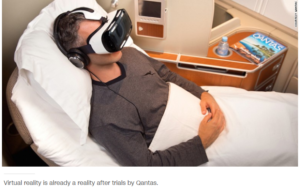 Qantas has already rolled out VR sets for first class passengers on some select flights between Australia and Los Angeles, with encouraging results.
Qantas has already rolled out VR sets for first class passengers on some select flights between Australia and Los Angeles, with encouraging results.New generation in-flight entertainment isn't going to be enjoyable without a comfortable environment to experience it in.
Providing a nice, relaxing atmosphere in a cramped metal tube is always going to be a challenge, but moves are afoot to improve that.
LED lighting has already proven effective during night flights, even apparently reducing jet lag.
No wonder both Boeing's next generation aircraft and the "Airspace by Airbus" cabin, rolled out on Airbus A330neo and A350 aircraft, make extensive use of LEDs.
Extra comfort is also coming from the constant accumulation of incremental ergonomic improvements.
These are the things that passengers barely notice on their own but put together make a difference between a good and a great travel experience.
Such as lavatories with anti-bacterial surfaces, or better designed overhead bins that reduce boarding time by making it easier to store hand luggage.
Many of the industry's creative energies are being devoted to creating the perfect airline seat.
It may come as a surprise to those stuck at the back of the economy class cabin, but these are exciting times for the aircraft seating industry.
An increasing number of airlines are discontinuing first class, but those that keep it are making it way more opulent, such as Etihad with its Residence.
Discontinuing first has led many airlines to upgrade their business class, opening a gap for the introduction of premium economy services.
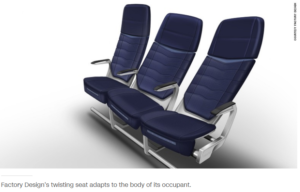 Some carriers are pondering a more basic economy class, but does that mean radical proposals for standing-only planes will soon be realized?
Some carriers are pondering a more basic economy class, but does that mean radical proposals for standing-only planes will soon be realized?Experts at passenger comfort innovators Zodiac Aerospace don't think so.
They say certification costs and reputation risks may simply not be worth it, particularly when existing seats with pitches of 30 inches or less are already very efficient.
"I really can't foresee this happening in the near future," says Victor Carlioz, an advanced concept engineer at Zodiac Aerospace.
"Instead we'll see a focus toward more innovative features in the economy class seat.
A compromise may be the flex-up seat proposed by Aviointeriors.
The Italian manufacturer is exploring a cinema-style seat for economy class that folds up vertically when unoccupied, allowing easier movement around the plane.
Ingo Wuggetzer, of Airbus, highlights how personalization is also becoming a thing in aircraft interiors.
The industry ideal is to create a seat that adapts perfectly to a passenger's body.
In 2011 the European manufacturer unveiled its "Future by Airbus" concept that outlined, among other things, the company's vision of the passenger cabin of 2050.
This included its own interpretation of the "smart seat" — one able to recognize and adapt to its occupant ergonomically and through entertainment preferences.
A first step in that direction may be the "twisting seat" concept proposed by London-based Factory Design.
Creative director Adam White says the flexible structure is based upon a careful anatomical study of the multiple positions that the back adopts while seated.
Sleeping rooms
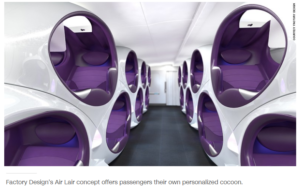 White is also behind Air Lair, a concept of sleeping pods that immerse premium travelers in a futuristic cocoon with adjustable light, sound and temperature.
White is also behind Air Lair, a concept of sleeping pods that immerse premium travelers in a futuristic cocoon with adjustable light, sound and temperature.Other designs envisage adding sleeping rooms in standard aircraft cabins.
Carlioz and his Zodiac Aerospace team, for example, see potential in using an aircraft's cargo space and area between the stowage bins and fuselage to accommodate bunks.
"It's simply a question of who has the ambition and willingness to invest into a project of this scale and truly break the mold," says the company's industrial designer, Matthew Cleary.
Sounds radical, but perhaps not so much once the likely evolution of current technologies and concepts are taken into account.
"Design houses really are competing fiercely for airline business and that means they are also pushing the limits of creativity," says Runway Girl Network's Simson.
"Designs are becoming more intuitive, fabrics more breathable and inner-foam materials are being developed to stay cooler (which adds to comfort).
"Increasingly, we see seat designers taking cues from the automotive industry too, with auto seat makers such as Recaro and Mirus having started successful aero divisions."
Airbus's Wuggetzer says there's potential to develop powerful strategies to produce standout cabin features, even in economy class.
Transparency is key, he adds.
"The same way that travelers are used to comparing hotels and check reviews on TripAdvisor, innovation in the cabin experience could lead to more differentiation between the experience provided not just on different aircraft types, but on different airlines."
The golden age of air travel may be just starting, after all.